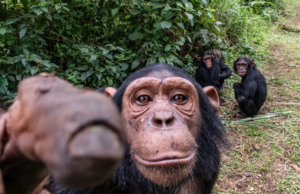Pushed to the brink of extinction

By Abhijit Mohanty /Down to the Earth
Chimpanzees, who share about 98 per cent of their genes with humans, are fast heading towards extinction. Among the rarest subspecies is the Nigeria-Cameroon Chimpanzee—less than 6,000 are left in the forests north of the Sanga River in Cameroon and in southwestern Nigeria. It has been designated as a critically endangered species by the International Union of Conservation of Nature (IUCN), and if urgent steps are not taken, scientists say it will become extinct in less than two decades.
The threats to their existence are many. In the drier parts of their habitat range such as the Mbam Djerem National Park, the Bamenda Highlands in Cameroon and Gashaka Gumti and Mambilla in Nigeria, pastoralists have encouraged forest fires to provide more grazing land for their livestock, which are subsequently being converted to farmlands. Habitat destruction has increased noise distrubances, forcing the Nigeria-Cameroon Chimpanzees to move into areas occupied by other chimpanzee communities, where they face aggression, resulting in fatalities.
Conservation biologists Jennifer Arubemi Agaldo, Gwom Thomas Gwom and Paul Tersoo Aperverga conducted a survey in 2011-2012 and found the habitat areas littered with spent cartridges, wire snares and logged trees. This indicates that chimpanzees are under serious threat from hunting and poaching activities, and the presence of logged wood indicates habitat destruction and degradation.
Bushmeat and habitats
The threats to their survival are further exacerbated by the rapid growth of human population. As human population has grown steadily in both Cameroon and Nigeria, the ease of obtaining arms, more efficient transport systems, and higher financial incentives to supply urban markets with “bushmeat” and other forest commodities have led to a situation, where swathes of land have been cleared of wildlife and often also their forest cover. Hunting of chimpanzees to supply the “bushmeat” market and to a lesser extent, to provide body parts for traditional medicine is one of the greatest threats to their survival.
“In recent years, hunting for bushmeat, which was once a subsistence activity, has become heavily commercialised and much of the meat goes to urban residents, who can afford to pay premium prices,” says Kari Jackson, who heads SURUDEV, a Cameroon-based non-profit that works with communities on biodiversity conservation. Interestingly, many of the carcasses found in the eastern Nigerian markets come from Cameroon, but are traded in Nigeria where bush-meat fetches higher prices.
Satellite images show that more than 3,000 hectares (ha) of rainforest bordering the Dja Faunal Reserve in Cameroon’s Southern region have been destroyed. The cleared forest, which was until recently the habitat for the western-lowland gorillas, chimpanzees and mandrills, was given to a Chinese company for palm oil plantations. The land was given to the company even though it is located in the Dja Faunal Reserve, which is a designated “UNESCO World Heritage Site”.
In 2009, a Cameroon minister awarded a 99-year lease to more than 73,000 ha of land to Herakles Farms, an American palm and timber company. Though land tenure laws prohibit leasing land more than 40 ha, a presidential decree was obtained in 2013—four years after Herakles arrived in Cameroon—to facilitate operations. Based in New York, Herakles Farms has claimed that its palm oil project in Cameroon’s South-West Region would cultivate in an area of little conservation value.
But a recent study by Dschang University in Cameroon, in collaboration with Germany’s University of Gottingen and supported by Greenpeace International, Save Wildlife Conservation Fund of Germany and WWF Germany, indicates that this claim undermines the rich biodiversity of the area. It says that the company plans to convert the neighbouring areas into palm oil plantations, which means crucial habitats used by chimpanzees and other endangered animals will be wiped out. “Our survey shows that the area is of high conservation value, while some parts could even act as a chimpanzee sanctuary,” says Kadiri Serge Bobo of Dschang University. The destruction of habitats has fragmented chimpanzee populations, and those that remain are small and isolated.
Community efforts
In the last decade, there has been a growing concern to save and protect this endangered species, especially among some non-profits with the support of international agencies, who are playing a crucial role to involve local communities in wildlife conservation-based projects. For instance, SURUDEV has been working with the local communities in the Kom-Wum Forest Reserve. “We have established Village Forest Protection Committees who provide training to members and local people on the importance of forests, wildlife protection and the regeneration of forest cover,” says Jackson.
Though these conservation efforts have created an enabling environment, this is just a drop in the ocean. A pragmatic approach is needed to protect these rarest apes. More-over, conservation research is required to steer initiatives in the right direction and attain sustainability. By identifying the ecological factors that influence distribution, ranging patterns and core habitat requirements, it is possible to identify suitable chimpanzee habitats. “Governments need to urgently develop a participatory land use planning process prior to allocating industrial concessions. Projects that are being developed without adequate community participation should not be allowed,” says Filip Verbelen of Greenpeace International. “If proactive strategies to mitigate the effects of large scale habitat conversion are not implemented soon, we can expect a rapid decline in African primate diversity,” says Joshua Linder, an assistant professor of anthropology at James Madison University, Virginia, USA.
Source: http://www.downtoearth.org.in/news/last-shots-58656#.Wb40ey_VGCs.facebook

 Español
Español
 Português
Português








